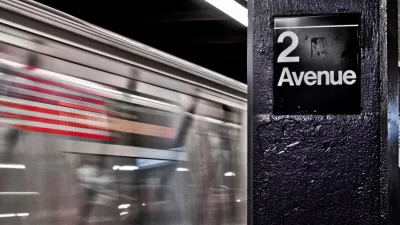As New York City faces its worst financial crisis in 2 decades, a NYC D.O.T. study was released showing that from 2003-2007, the increase in jobs and people was accompanied by a slight decrease in traffic due primarily to increased transit usage.
"The study is the first analysis to take an overall look at traffic and transit patterns in New York during the boom years from 2003 through 2007, when, according to the report, the city added more than 200,000 jobs and its population increased by more than 130,000."
"'What you see is that for the first time since at least World War II, all of the growth in travel in the city has been absorbed by non-auto modes, primarily by mass transit,' said Bruce Schaller, New York's deputy transportation commissioner for planning and sustainability, who wrote the study, which is to be released on Monday (12/15).
The study revealed that "the volume of traffic on the streets and highways remained largely unchanged, in fact declining slightly. Instead, virtually the entire increase in New Yorkers' means of transportation during those robust years occurred in mass transit, with a surge in subway, bus and commuter rail riders."
"'...we've really turned a corner in the city in that all of the growth in travel over the last four years has been absorbed by mass transit and so, in terms of the city's sustainability goals, this is very encouraging to see,' said Schaller."
FULL STORY: New York City Grew, but Traffic Didn’t

Planetizen Federal Action Tracker
A weekly monitor of how Trump’s orders and actions are impacting planners and planning in America.

Map: Where Senate Republicans Want to Sell Your Public Lands
For public land advocates, the Senate Republicans’ proposal to sell millions of acres of public land in the West is “the biggest fight of their careers.”

Restaurant Patios Were a Pandemic Win — Why Were They so Hard to Keep?
Social distancing requirements and changes in travel patterns prompted cities to pilot new uses for street and sidewalk space. Then it got complicated.

Platform Pilsner: Vancouver Transit Agency Releases... a Beer?
TransLink will receive a portion of every sale of the four-pack.

Toronto Weighs Cheaper Transit, Parking Hikes for Major Events
Special event rates would take effect during large festivals, sports games and concerts to ‘discourage driving, manage congestion and free up space for transit.”

Berlin to Consider Car-Free Zone Larger Than Manhattan
The area bound by the 22-mile Ringbahn would still allow 12 uses of a private automobile per year per person, and several other exemptions.
Urban Design for Planners 1: Software Tools
This six-course series explores essential urban design concepts using open source software and equips planners with the tools they need to participate fully in the urban design process.
Planning for Universal Design
Learn the tools for implementing Universal Design in planning regulations.
Heyer Gruel & Associates PA
JM Goldson LLC
Custer County Colorado
City of Camden Redevelopment Agency
City of Astoria
Transportation Research & Education Center (TREC) at Portland State University
Camden Redevelopment Agency
City of Claremont
Municipality of Princeton (NJ)



























